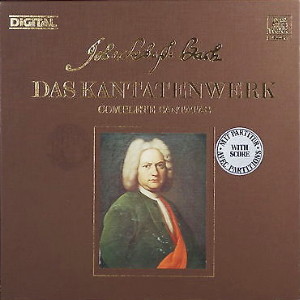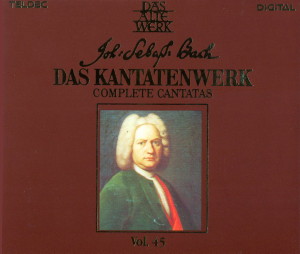 |
|
2 LPs
- 244-194-1 EX - (p) 1989
|
 |
| 2 CDs -
244-194-2 ZL - (p) 1989 |
|
| DAS KANTATENWERK - Volume 45 |
|
|
|
|
|
|
|
| Johann Sebastian
BACH (1685-1750) |
Kantate
"Gott ist unsre Zuversicht", BWV 197
|
|
30' 01" |
|
|
Trauungskantate
|
|
|
|
|
Textdichter
unbekannt; 5. Martin Luther 1524; 10. nach
Georg Neumark 1657
|
|
|
|
|
Solo:
Sopran, Alt, Baß - Chor; Tromba I, II,
III; Oboe d'amore I, II; Oboe I, II;
Fagotto; Timpani; Violino I, II, Viola;
Continuo (Violoncello, Violone, Organo)
|
|
|
|
|
Vor
der Trauung
|
|
|
|
|
- 1.
Chor: "Gott ist unsre Zuversicht"
|
6' 17" |
|
B1 |
|
- 2.
Recitativo (Basso): "Gott ist und bleint
der beste Sorger" |
1' 15" |
|
B2 |
|
- 3.
Aria (Alto): "Schläfert allen
Sorgenkummer" |
6' 42" |
|
B3 |
|
- 4.
Recitativo (Basso): "Drum folget Gott und
seinem Triebe" |
0' 53" |
|
B4 |
|
- 5.
Choral: "Du süße Lieb, schenk uns deine
Gunst" |
1' 04" |
|
B5 |
|
Nach
der Trauung |
|
|
|
|
- 6.
Aria (Basso): "O du angenehmes Paar" |
5' 38" |
|
B6 |
|
- 7.
Recitativo (Soprano): "So wie es Gott mit
dir getreu" |
1' 46" |
|
B7 |
|
- 8.
Aria (Soprano): "Vergnügeb und Lust" |
4' 31" |
|
B8 |
|
- 9.
Recitativo (Basso): "Und dieser frohe
Lebenslauf" |
0' 54" |
|
B9 |
|
- 10.
Choral: "Sing, bet und geh auf Gottes
Wegen" |
0' 54" |
|
B10 |
|
|
|
|
|
|
Kantate
"Laß, Fürstin, laß noch einen Strahl",
BWV 198 |
|
35' 14" |
|
|
Trauerode |
|
|
|
|
Text:
Johann Christoph Gottsched (1700-1766) |
|
|
|
|
Solo:
Sopran, Alt, Tenor, Baß - Chor; Oboe I,
II: Oboe d'amore I, II; Flauto traverso I,
II; Viola da gamba I, II; Liuto; Violino
I, II, Viola; Continuo (Violoncello,
Violone, Organo, Cembalo) |
|
|
|
|
Prima
Parte
|
|
|
|
|
- 1.
Chor: "Laß, Fürstin, laß noch einen
Strahl" |
6' 12" |
|
C1 |
|
- 2.
Recitativo (Soprano): "Dein Sachsen, dein
bestürztes" |
1' 15" |
|
C2 |
|
- 3.
Aria (Soprano): "Verstummt, verstummt, ihr
holden Saiten" |
4' 04" |
|
C3 |
|
- 4.
Recitativo (Alto): "Der Glocken bebendes
Getön" |
0' 46" |
|
C4 |
|
- 5.
Aria (Alto): "Wie starb die Heldin so
vergnügt" |
7' 46" |
|
C5 |
|
- 6.
Recitativo (Tenore): "Ihr Leben liesß die
Kunst zu sterben" |
1' 11" |
|
C6 |
|
- 7.
Chor: "An dir, du Vorbild großer Frauen" |
2' 15" |
|
C7 |
|
Seconda
Parte
|
|
|
|
|
- 8.
Aria (Tenor): "Der Ewigkeit saphirmes
Haus" |
4' 06" |
|
C8 |
|
- 9.
Recitativo (Baß): "Was Wunder ist' s?" |
2' 31" |
|
C9 |
|
- 10.
Chor: "Doch Königin! Du stirbest nicht" |
5' 03" |
|
C10 |
|
|
|
|
|
Jan
Patrick o'Farell (Solist des Knabenchores
Hannover), Sopran
René Jacobs, Alt
John
Elwes, Tenor
(BWV 198)
Harry van der Kamp, Baß
Knabenchor Hannover |
Heinz Hennig, Leitung
Collegium Vocale Gent | Philippe
Herreweghe, Leitung
LEONHARDT-CONSORT mit
Originalinstrumenten
- Friedemann Immer, Klaus Osterloh, François
Petit-Laurent, Trompeten
- Ku Ebbinge, Michel Henry, Oboe und
Oboe d'amore
- Ricardo Kanji, Marten Root,
Flöten
- Frans Berkhout, Fagott
- Michael de Roo, Pauken
- Anneke Poes, Richte van der Meer, Viola
da gamba
- Fred Jacobs, Liuto
- Alda Stuurop, Marinette Troost, Antoinette
van den Hombergh, Lucy van Dael, Marie
Leonhardt, Violinen
- Staas Swiestra, Ruth Hesseling, Violen
- Richte van der Meer, Wouter Möller, Violoncelli
- Anthony Woodrow, Violone
- Siebe Henstra, Cembalo
- Bob van Asperen, Gustav Leonhardt (BWV
197/2,7), Orgel
Gustav Leonhardt, Gesamtleitung
|
|
|
|
|
Luogo
e data di registrazione |
|
Lutherse Kerk,
Haarlem (Holland) - Gennaio 1988
|
|
|
Registrazione: live
/ studio |
|
studio |
|
|
Producer |
|
Wolfgang Mohr
|
|
|
Recording
Producer
|
|
Friedemann
Engelbrecht
|
|
|
Sound Engineer
|
|
Michael Brammann
|
|
|
Prima Edizione LP |
|
Teldec "Das Alte
Werk" | 244 194-1 EX | 2 LPs -
durata 42' 25" - 59' 16" | (p)
1989 | DIGITAL DMM
|
|
|
Edizione CD |
|
Teldec Classics |
LC 6706 | 244 194-2 ZL | 2 CDs -
durata 42' 25" - 59' 16" | (p)
1989 | DDD |
|
|
Cover
|
|
Johann Sebastian
Nach, einige Jahre vor seiner
Ernennung zum Kantor in Leipzig.
Gemälde con JJ. Ihle (1720) Bach
Museum Eisenach.
|
|
|
Note |
|
In questo volume sono
presenti anche La Cantate BWV 196
e BWV 199 a cura del Concentus
Musicus Wien diretto da Nikolaus
Harnoncourt.
|
|
|
|
|
INTRODUCTION
by Nele Anders
"Gott ist unsre
Zuversicht" (BWV 197)
was composed as a wedding
cantata in 1736/37.
Movements written prior to
this, however (Nos. 6 &
8), from a Christmas cantata
Ehre ser Gott in der Höhe
(BWV 197a) among other
sources, were reused here -
a procedure frequently
applied by Bach, correctly
called "parodying," which
remains the subject of
continual rethinking for
Bach scholars. The festive
instrumentation is in
keeping with the nature of
the occasion for which the
work was written: three
trumpets, two oboos d’amore,
bassoon, string ensemble and
continuo, plus three vocal
soloists and a four-part
choir. Each of the work’s
two sections closes with a
chorale: No. 5 with "Du suße
Lieb, schenk uns deine
Gunst" (1524), No. 10 - the
text is missing in the
autograph manuscript - with
"Sing, bet und geh auf
Gottes Wegen" of 1657. The
introductory chorus is
preceded by an instrumental
Sinfonia with which it is
linked thematically. Both
the three arias and the four
recitatives are laid out
very differently from one
another. The varied da capo
aria ”Schläfert allen
Sorgenkummer" (No. 3) with
obbligato oboe d'amore, with
strictly hierarchically
structured string writing
and the striking, evenly
flowing basso continuo,
deserves particular
attention for the reciprocal
connections between the
vocal and instrumental
spheres.
Though Gottsched lived in
the same town as Bach for no
fewer than 26 years, the
great composer, who was 15
years older; only wrote
three settings of texts by
the central poet of the
German Literary
Enlightenment. One of these
is the "Funeral Ode"
(BWV 198) notable for
its verses written in
German, which were intended
to show "how well and with
what dexterity one can
express oneself in the
German language.”
Gottsched’s unusual choice
of language for the ode
genre was doubtless
influenced by the
exceptional popularity of
the Queen and Electress
Christiane Eberhardine. In a
Saxony torn by religious
strife, she had adhered to
the Protestant faith,
whereas her spouse had
converted to Catholicism.
The citizens of Leipzig
showed their gratitude and
approval for this
steadfastness with an
impressive funeral service
on October 17, 1727 in the
University Church. Bach’s
funeral music "in the
Italian manner,” the cantata
Laß, Fürstin, laß noch einen
Strahle (BWV 198) was
performed here, both before
and after the eulogy of
praise and mourning given by
"the Assessor of the Royal
and Electoral Supreme Court
of Freiburg, Hans Carl von
Kirbach." "In the Italian
manner" meant that the
recitatives and arias of the
cantata were accompanied on
the harpsichord, in addition
to the obbligato
instruments. Of course, Bach
had to reshape Gottsched’s
ten-stanza ode into a text
that satisfied him
musically: a remarkable
procedure that gives us an
insight into Bach's way of
thinking as a composer. The
resulting ten movements -
three choruses, four
recitatives and three arias
- allowed Bach to compose
music rich in associations,
and his alternations to the
text intensify individual
expression and the
subjective emotional effect
on the listener, and make
the whole altogether more
vivid. Bach endowed the work
with rich scoring, and made
skilful use of the variable
sound potential thus
achieved to give more
differentiated expression to
the feelings of grief and
despair, of admiration and
mourning. As in the great
Passions, the work is
brought to a close by a
simple choral movement
symbolizing human
magnanimity and fidelity of
character.
|
  |
|
|